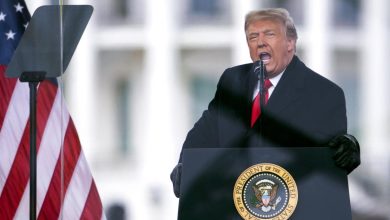Powell says it will take ‘longer than expected’ for inflation to reach Fed’s 2% target

Federal Reserve Chairman Jerome Powell said Tuesday it would take “longer than expected” to achieve the confidence needed to return inflation to the central bank’s 2% target, signaling that he It will also likely take longer to reduce rates.
“Given the strength of the labor market and the progress made on inflation so far, it is appropriate to allow more time for restrictive policy to act and to let the data and evolving outlook inform us guide,” Powell said at an event in Washington on the Canadian economy.
The comments mark Powell’s first acknowledgment that tough inflation data from the first quarter of this year does not show the progress the Fed needs to begin easing monetary policy.
Rates are currently at their highest level in 23 years, following an aggressive campaign by the Fed to control inflation and cool the economy.
Powell’s new stance is a departure from comments just two weeks ago, when Powell assured that the overall outlook had not changed much despite warmer-than-expected numbers at the start of the year.
He then said central bank officials expected a rate cut “at some point” this year. On Tuesday, he offered no assurances or forecasts of rate cuts.
Instead, Powell said he thinks the Fed’s preferred inflation gauge — the personal consumption expenditures (PCE) price index excluding volatile food and gas prices — will be little modified between March and February.
PCE was 2.8% in February, well above the Fed’s target. The March figures will be officially released next week.
“We told the FOMC that we need to have more confidence that inflation is moving sustainably toward 2% before it is appropriate to ease policy,” he said. “Recent data has clearly not given us greater confidence and instead indicates that it will likely take longer than expected to achieve that confidence.”
Inflation fears are growing on Wall Street. Markets were roiled last week following warmer-than-expected data for the third straight month from another measure of inflation: the Consumer Price Index (CPI).
The CPI rose 3.5% from a year earlier in March, an acceleration from the 3.2% annual price increase in February and more than economists expected.
The year-on-year change in the so-called core CPI – which excludes volatile food and energy prices – was 3.8%, the same level as in February but a tenth percent more than expected.
Traders who were betting on a decline in June have taken that option off the table. They now estimate that there is almost an 85% chance that the Fed will do nothing in June and about a 40% chance that it will make a cut in July.
The odds now favor September as the first rate cut.
Investors also reduced the number of rate cuts planned this year to two, fewer than the median of three forecast by Fed officials at their last policy meeting in March.
Although inflation was higher in the first quarter, underscoring the reasons not to cut rates, the labor market also posted stronger numbers and March retail sales showed that consumers continue to spending at a solid rate.
Powell was not the only Fed official to hint at a longer timetable for any rate cuts. Fed Vice Chairman Philip Jefferson warned in a speech in Washington on Tuesday that if inflation remains high, then rates are likely to stay high for longer.
“My baseline outlook continues to be that inflation will continue to decline,” he said.
“Of course, the outlook is still quite uncertain, and if the available data suggests that inflation is more persistent than I currently expect, it will be appropriate to maintain the current restrictive policy for longer.”
Click here for in-depth analysis of the latest stock market news and events that move stock prices..
Read the latest financial and business news from Yahoo Finance
yahoo





